HI6028 Taxation Law: Analyzing Capital Gains Tax and Fringe Benefits
VerifiedAdded on 2023/06/04
|13
|3144
|404
Report
AI Summary
This report provides a detailed analysis of Capital Gains Tax (CGT) and Fringe Benefit Tax (FBT) liabilities based on provided scenarios. The CGT analysis covers the sale of vacant land, an antique bed, shares, and a violin, determining taxable gains or losses based on purchase dates, cost bases, and applicable discount methods, while also considering pre-CGT asset status and personal use exemptions. The FBT analysis focuses on car and loan fringe benefits provided to an employee, calculating taxable values using statutory formulas and relevant gross-up factors, while adhering to interest rate benchmarks. The report uses relevant sections of the ITAA 1997 and FBTAA to support its conclusions.
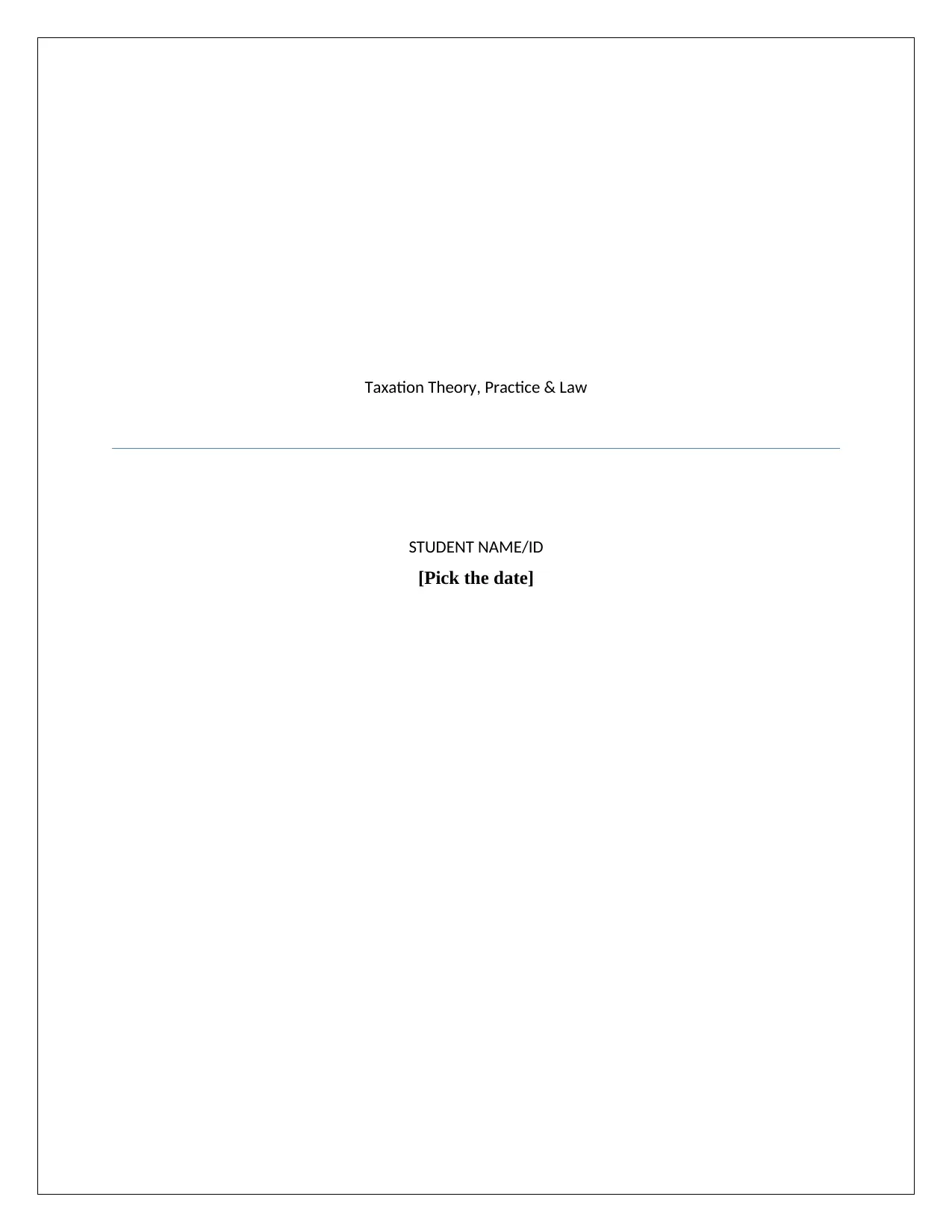
Taxation Theory, Practice & Law
STUDENT NAME/ID
[Pick the date]
STUDENT NAME/ID
[Pick the date]
Paraphrase This Document
Need a fresh take? Get an instant paraphrase of this document with our AI Paraphraser
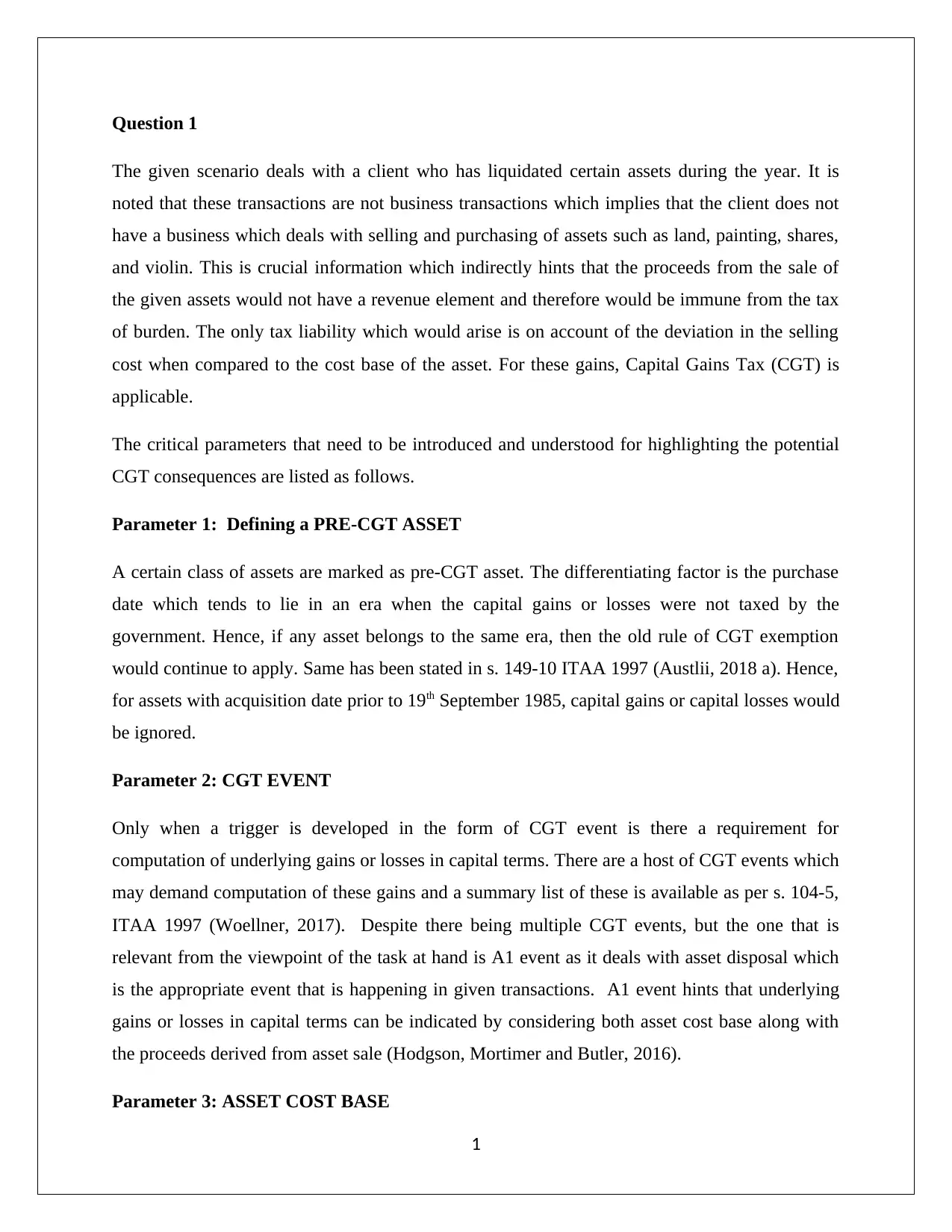
Question 1
The given scenario deals with a client who has liquidated certain assets during the year. It is
noted that these transactions are not business transactions which implies that the client does not
have a business which deals with selling and purchasing of assets such as land, painting, shares,
and violin. This is crucial information which indirectly hints that the proceeds from the sale of
the given assets would not have a revenue element and therefore would be immune from the tax
of burden. The only tax liability which would arise is on account of the deviation in the selling
cost when compared to the cost base of the asset. For these gains, Capital Gains Tax (CGT) is
applicable.
The critical parameters that need to be introduced and understood for highlighting the potential
CGT consequences are listed as follows.
Parameter 1: Defining a PRE-CGT ASSET
A certain class of assets are marked as pre-CGT asset. The differentiating factor is the purchase
date which tends to lie in an era when the capital gains or losses were not taxed by the
government. Hence, if any asset belongs to the same era, then the old rule of CGT exemption
would continue to apply. Same has been stated in s. 149-10 ITAA 1997 (Austlii, 2018 a). Hence,
for assets with acquisition date prior to 19th September 1985, capital gains or capital losses would
be ignored.
Parameter 2: CGT EVENT
Only when a trigger is developed in the form of CGT event is there a requirement for
computation of underlying gains or losses in capital terms. There are a host of CGT events which
may demand computation of these gains and a summary list of these is available as per s. 104-5,
ITAA 1997 (Woellner, 2017). Despite there being multiple CGT events, but the one that is
relevant from the viewpoint of the task at hand is A1 event as it deals with asset disposal which
is the appropriate event that is happening in given transactions. A1 event hints that underlying
gains or losses in capital terms can be indicated by considering both asset cost base along with
the proceeds derived from asset sale (Hodgson, Mortimer and Butler, 2016).
Parameter 3: ASSET COST BASE
1
The given scenario deals with a client who has liquidated certain assets during the year. It is
noted that these transactions are not business transactions which implies that the client does not
have a business which deals with selling and purchasing of assets such as land, painting, shares,
and violin. This is crucial information which indirectly hints that the proceeds from the sale of
the given assets would not have a revenue element and therefore would be immune from the tax
of burden. The only tax liability which would arise is on account of the deviation in the selling
cost when compared to the cost base of the asset. For these gains, Capital Gains Tax (CGT) is
applicable.
The critical parameters that need to be introduced and understood for highlighting the potential
CGT consequences are listed as follows.
Parameter 1: Defining a PRE-CGT ASSET
A certain class of assets are marked as pre-CGT asset. The differentiating factor is the purchase
date which tends to lie in an era when the capital gains or losses were not taxed by the
government. Hence, if any asset belongs to the same era, then the old rule of CGT exemption
would continue to apply. Same has been stated in s. 149-10 ITAA 1997 (Austlii, 2018 a). Hence,
for assets with acquisition date prior to 19th September 1985, capital gains or capital losses would
be ignored.
Parameter 2: CGT EVENT
Only when a trigger is developed in the form of CGT event is there a requirement for
computation of underlying gains or losses in capital terms. There are a host of CGT events which
may demand computation of these gains and a summary list of these is available as per s. 104-5,
ITAA 1997 (Woellner, 2017). Despite there being multiple CGT events, but the one that is
relevant from the viewpoint of the task at hand is A1 event as it deals with asset disposal which
is the appropriate event that is happening in given transactions. A1 event hints that underlying
gains or losses in capital terms can be indicated by considering both asset cost base along with
the proceeds derived from asset sale (Hodgson, Mortimer and Butler, 2016).
Parameter 3: ASSET COST BASE
1

A term outlined above is cost base which is a defined term in accordance with s. 110-25 ITAA
1997. It does not comprise of only the purchase price which is the most obvious element but
other elements besides this also are involved as can be hinted below (ATO, 208 c).
Hence, the asset cost base is the cumulative cost obtained by adding the above five mentioned
elements related with the underlying asset (Hodgson, Mortimer and Butler, 2016).
Parameter 4: DISCOUNT METHOD
Before the application of CGT on the capital gains derived from A1 event approach, the capital
gains are reduced through concession available in the form of s. 115-25 (Austlii, 2018 b). The
method described in this section is called the discount method and is extended to individual
taxpayers along with small businesses but not to companies. As per this method, on long term
capital gains (i.e. asset was held > 1 year), the taxpayer can claim a flat discount of 50% to
compute the taxable capital gains which would finally contribute to CGT (Coleman, 2016).
Parameter 5: CAPITAL LOSSES ADJUSTMENT
It is quite possible that the CGT event might result in losses of capital nature and hence these
need to be dealt with as explained in s. 102-5 ITAA 1997 (Coleman, 2016). These capital losses
cannot be used for neutralising the assessable income from other sources but may only neutralise
the capital gains. If there is unavailability of these, then carry forward of capital losses is
permissible till the time that there is availability of capital gains for adjustment.
In wake of the above concepts, the requisite transactions for the taxpayer have been discussed
below.
2
1997. It does not comprise of only the purchase price which is the most obvious element but
other elements besides this also are involved as can be hinted below (ATO, 208 c).
Hence, the asset cost base is the cumulative cost obtained by adding the above five mentioned
elements related with the underlying asset (Hodgson, Mortimer and Butler, 2016).
Parameter 4: DISCOUNT METHOD
Before the application of CGT on the capital gains derived from A1 event approach, the capital
gains are reduced through concession available in the form of s. 115-25 (Austlii, 2018 b). The
method described in this section is called the discount method and is extended to individual
taxpayers along with small businesses but not to companies. As per this method, on long term
capital gains (i.e. asset was held > 1 year), the taxpayer can claim a flat discount of 50% to
compute the taxable capital gains which would finally contribute to CGT (Coleman, 2016).
Parameter 5: CAPITAL LOSSES ADJUSTMENT
It is quite possible that the CGT event might result in losses of capital nature and hence these
need to be dealt with as explained in s. 102-5 ITAA 1997 (Coleman, 2016). These capital losses
cannot be used for neutralising the assessable income from other sources but may only neutralise
the capital gains. If there is unavailability of these, then carry forward of capital losses is
permissible till the time that there is availability of capital gains for adjustment.
In wake of the above concepts, the requisite transactions for the taxpayer have been discussed
below.
2
⊘ This is a preview!⊘
Do you want full access?
Subscribe today to unlock all pages.

Trusted by 1+ million students worldwide
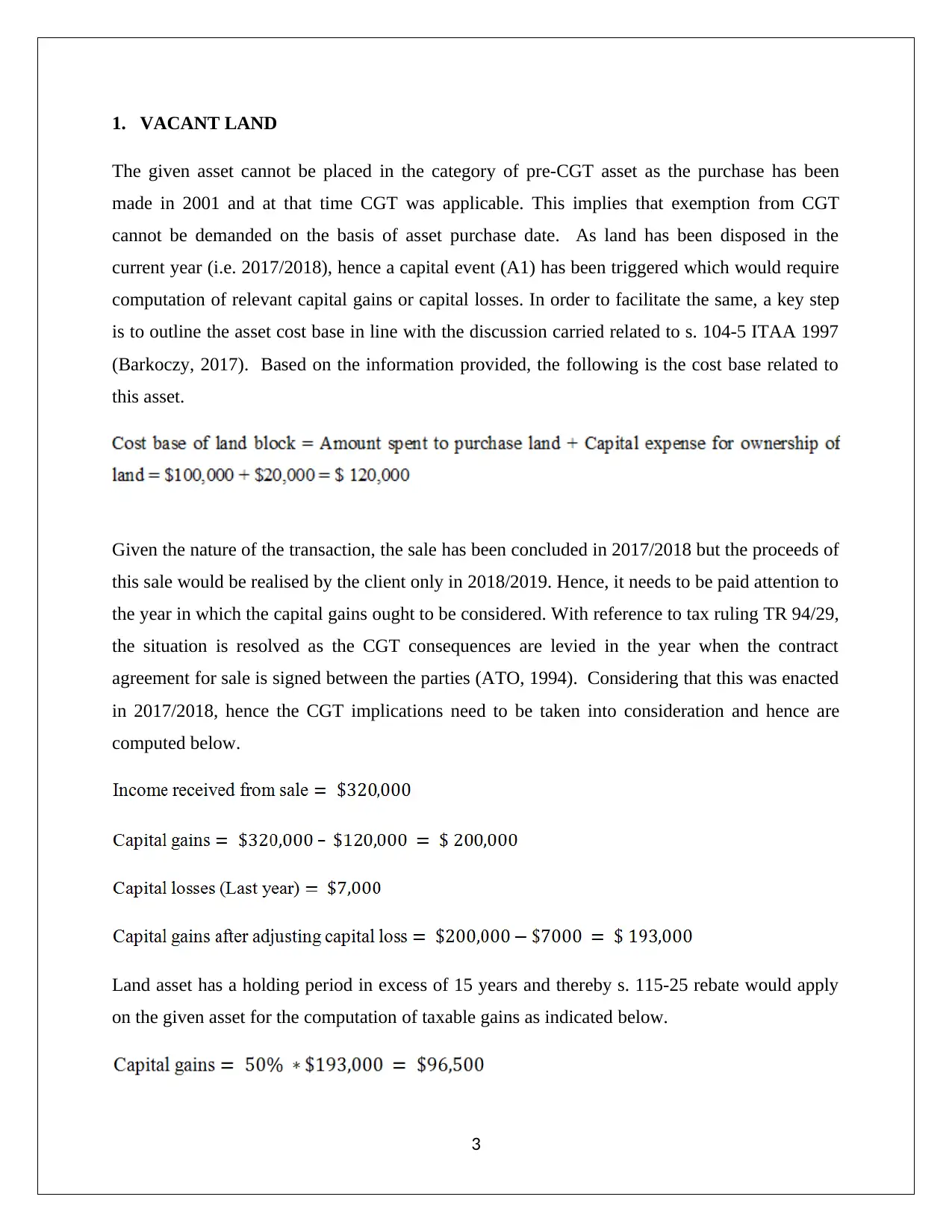
1. VACANT LAND
The given asset cannot be placed in the category of pre-CGT asset as the purchase has been
made in 2001 and at that time CGT was applicable. This implies that exemption from CGT
cannot be demanded on the basis of asset purchase date. As land has been disposed in the
current year (i.e. 2017/2018), hence a capital event (A1) has been triggered which would require
computation of relevant capital gains or capital losses. In order to facilitate the same, a key step
is to outline the asset cost base in line with the discussion carried related to s. 104-5 ITAA 1997
(Barkoczy, 2017). Based on the information provided, the following is the cost base related to
this asset.
Given the nature of the transaction, the sale has been concluded in 2017/2018 but the proceeds of
this sale would be realised by the client only in 2018/2019. Hence, it needs to be paid attention to
the year in which the capital gains ought to be considered. With reference to tax ruling TR 94/29,
the situation is resolved as the CGT consequences are levied in the year when the contract
agreement for sale is signed between the parties (ATO, 1994). Considering that this was enacted
in 2017/2018, hence the CGT implications need to be taken into consideration and hence are
computed below.
Land asset has a holding period in excess of 15 years and thereby s. 115-25 rebate would apply
on the given asset for the computation of taxable gains as indicated below.
3
The given asset cannot be placed in the category of pre-CGT asset as the purchase has been
made in 2001 and at that time CGT was applicable. This implies that exemption from CGT
cannot be demanded on the basis of asset purchase date. As land has been disposed in the
current year (i.e. 2017/2018), hence a capital event (A1) has been triggered which would require
computation of relevant capital gains or capital losses. In order to facilitate the same, a key step
is to outline the asset cost base in line with the discussion carried related to s. 104-5 ITAA 1997
(Barkoczy, 2017). Based on the information provided, the following is the cost base related to
this asset.
Given the nature of the transaction, the sale has been concluded in 2017/2018 but the proceeds of
this sale would be realised by the client only in 2018/2019. Hence, it needs to be paid attention to
the year in which the capital gains ought to be considered. With reference to tax ruling TR 94/29,
the situation is resolved as the CGT consequences are levied in the year when the contract
agreement for sale is signed between the parties (ATO, 1994). Considering that this was enacted
in 2017/2018, hence the CGT implications need to be taken into consideration and hence are
computed below.
Land asset has a holding period in excess of 15 years and thereby s. 115-25 rebate would apply
on the given asset for the computation of taxable gains as indicated below.
3
Paraphrase This Document
Need a fresh take? Get an instant paraphrase of this document with our AI Paraphraser
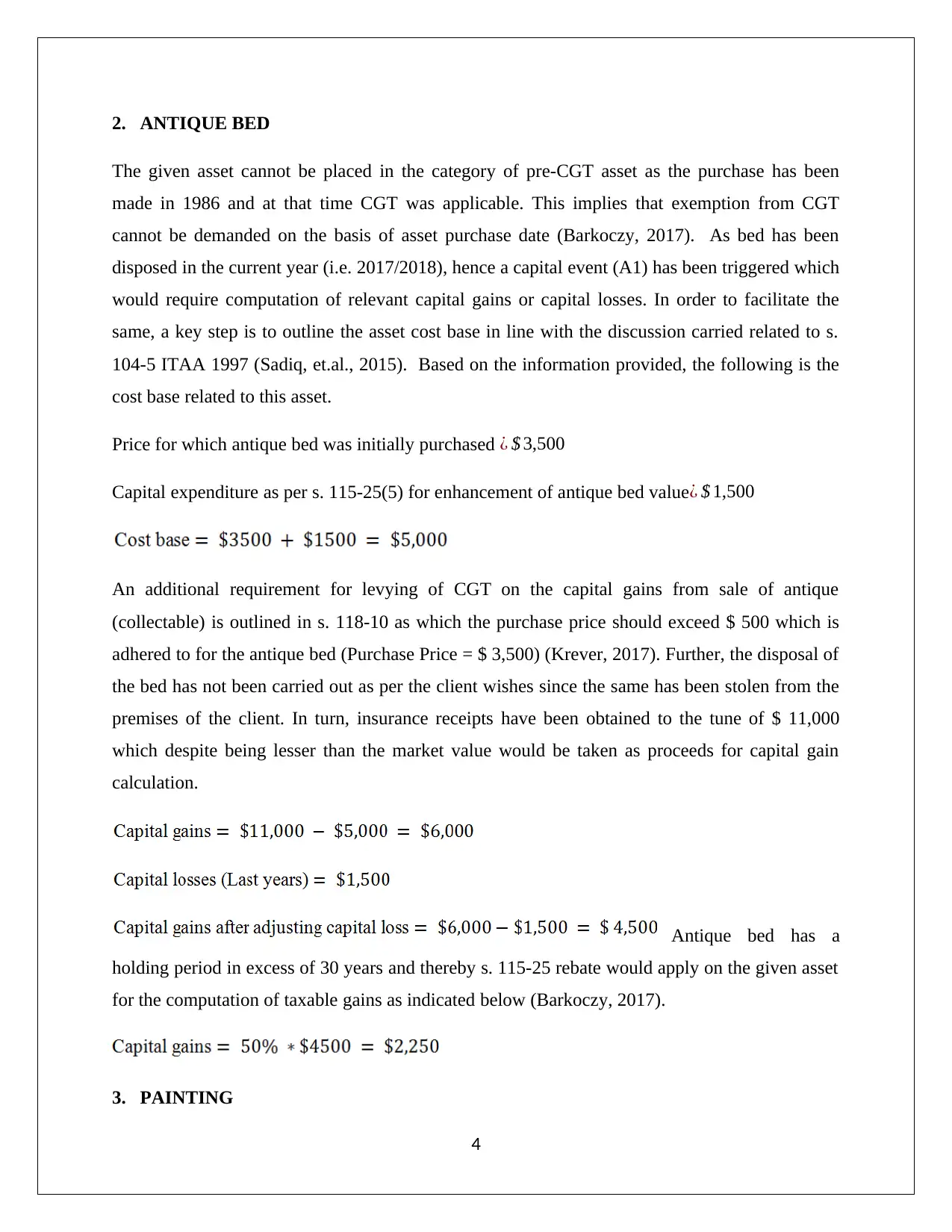
2. ANTIQUE BED
The given asset cannot be placed in the category of pre-CGT asset as the purchase has been
made in 1986 and at that time CGT was applicable. This implies that exemption from CGT
cannot be demanded on the basis of asset purchase date (Barkoczy, 2017). As bed has been
disposed in the current year (i.e. 2017/2018), hence a capital event (A1) has been triggered which
would require computation of relevant capital gains or capital losses. In order to facilitate the
same, a key step is to outline the asset cost base in line with the discussion carried related to s.
104-5 ITAA 1997 (Sadiq, et.al., 2015). Based on the information provided, the following is the
cost base related to this asset.
Price for which antique bed was initially purchased ¿ $ 3,500
Capital expenditure as per s. 115-25(5) for enhancement of antique bed value¿ $ 1,500
An additional requirement for levying of CGT on the capital gains from sale of antique
(collectable) is outlined in s. 118-10 as which the purchase price should exceed $ 500 which is
adhered to for the antique bed (Purchase Price = $ 3,500) (Krever, 2017). Further, the disposal of
the bed has not been carried out as per the client wishes since the same has been stolen from the
premises of the client. In turn, insurance receipts have been obtained to the tune of $ 11,000
which despite being lesser than the market value would be taken as proceeds for capital gain
calculation.
Antique bed has a
holding period in excess of 30 years and thereby s. 115-25 rebate would apply on the given asset
for the computation of taxable gains as indicated below (Barkoczy, 2017).
3. PAINTING
4
The given asset cannot be placed in the category of pre-CGT asset as the purchase has been
made in 1986 and at that time CGT was applicable. This implies that exemption from CGT
cannot be demanded on the basis of asset purchase date (Barkoczy, 2017). As bed has been
disposed in the current year (i.e. 2017/2018), hence a capital event (A1) has been triggered which
would require computation of relevant capital gains or capital losses. In order to facilitate the
same, a key step is to outline the asset cost base in line with the discussion carried related to s.
104-5 ITAA 1997 (Sadiq, et.al., 2015). Based on the information provided, the following is the
cost base related to this asset.
Price for which antique bed was initially purchased ¿ $ 3,500
Capital expenditure as per s. 115-25(5) for enhancement of antique bed value¿ $ 1,500
An additional requirement for levying of CGT on the capital gains from sale of antique
(collectable) is outlined in s. 118-10 as which the purchase price should exceed $ 500 which is
adhered to for the antique bed (Purchase Price = $ 3,500) (Krever, 2017). Further, the disposal of
the bed has not been carried out as per the client wishes since the same has been stolen from the
premises of the client. In turn, insurance receipts have been obtained to the tune of $ 11,000
which despite being lesser than the market value would be taken as proceeds for capital gain
calculation.
Antique bed has a
holding period in excess of 30 years and thereby s. 115-25 rebate would apply on the given asset
for the computation of taxable gains as indicated below (Barkoczy, 2017).
3. PAINTING
4
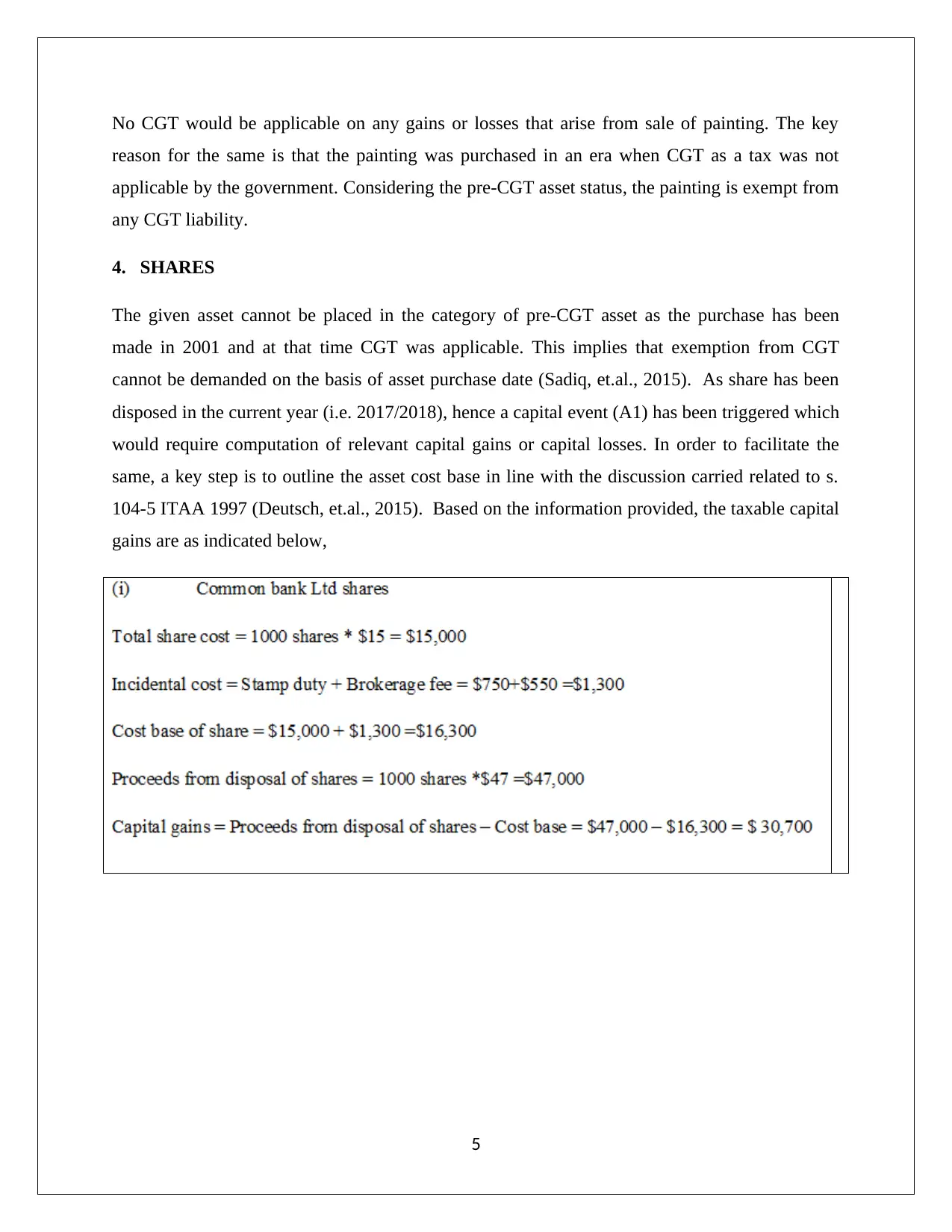
No CGT would be applicable on any gains or losses that arise from sale of painting. The key
reason for the same is that the painting was purchased in an era when CGT as a tax was not
applicable by the government. Considering the pre-CGT asset status, the painting is exempt from
any CGT liability.
4. SHARES
The given asset cannot be placed in the category of pre-CGT asset as the purchase has been
made in 2001 and at that time CGT was applicable. This implies that exemption from CGT
cannot be demanded on the basis of asset purchase date (Sadiq, et.al., 2015). As share has been
disposed in the current year (i.e. 2017/2018), hence a capital event (A1) has been triggered which
would require computation of relevant capital gains or capital losses. In order to facilitate the
same, a key step is to outline the asset cost base in line with the discussion carried related to s.
104-5 ITAA 1997 (Deutsch, et.al., 2015). Based on the information provided, the taxable capital
gains are as indicated below,
5
reason for the same is that the painting was purchased in an era when CGT as a tax was not
applicable by the government. Considering the pre-CGT asset status, the painting is exempt from
any CGT liability.
4. SHARES
The given asset cannot be placed in the category of pre-CGT asset as the purchase has been
made in 2001 and at that time CGT was applicable. This implies that exemption from CGT
cannot be demanded on the basis of asset purchase date (Sadiq, et.al., 2015). As share has been
disposed in the current year (i.e. 2017/2018), hence a capital event (A1) has been triggered which
would require computation of relevant capital gains or capital losses. In order to facilitate the
same, a key step is to outline the asset cost base in line with the discussion carried related to s.
104-5 ITAA 1997 (Deutsch, et.al., 2015). Based on the information provided, the taxable capital
gains are as indicated below,
5
⊘ This is a preview!⊘
Do you want full access?
Subscribe today to unlock all pages.

Trusted by 1+ million students worldwide
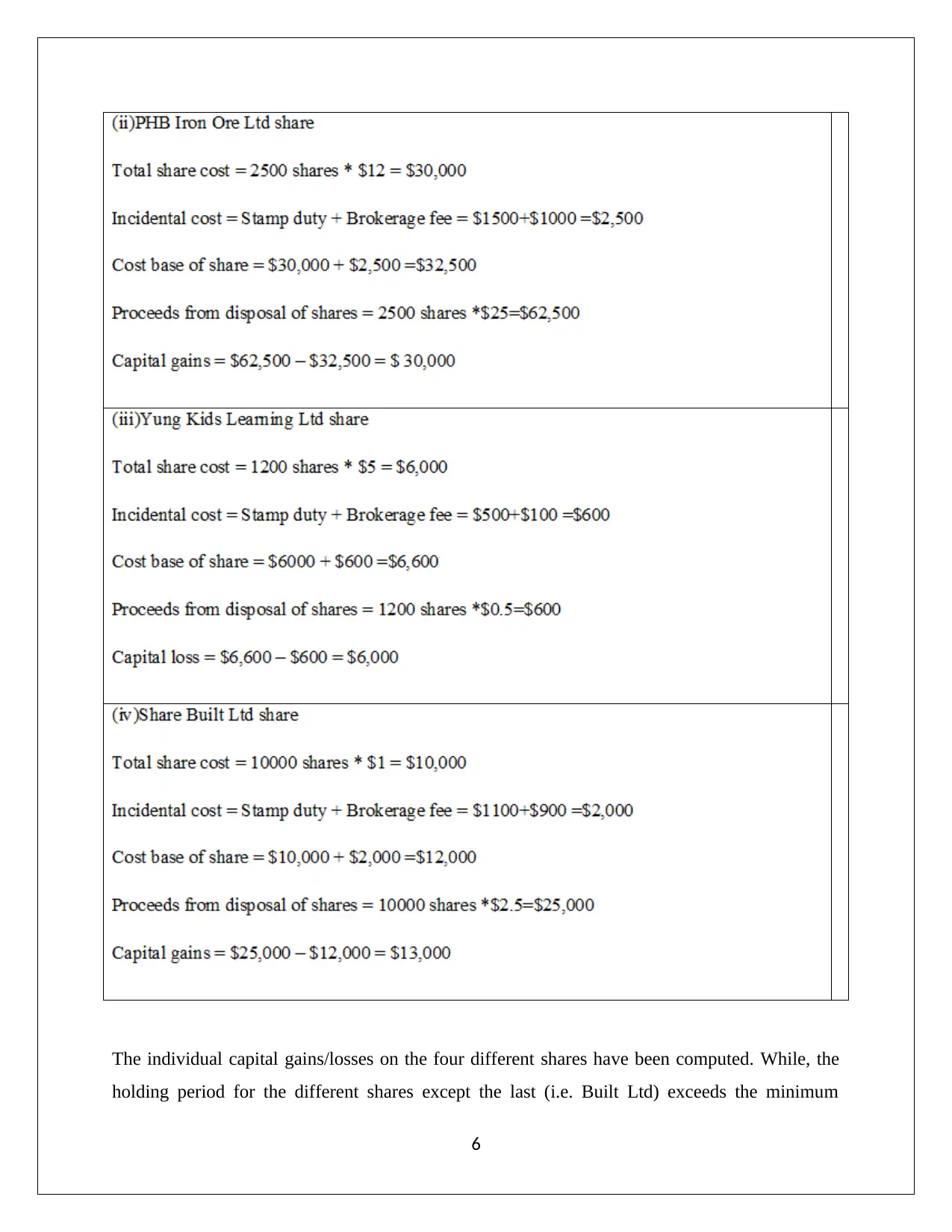
The individual capital gains/losses on the four different shares have been computed. While, the
holding period for the different shares except the last (i.e. Built Ltd) exceeds the minimum
6
holding period for the different shares except the last (i.e. Built Ltd) exceeds the minimum
6
Paraphrase This Document
Need a fresh take? Get an instant paraphrase of this document with our AI Paraphraser
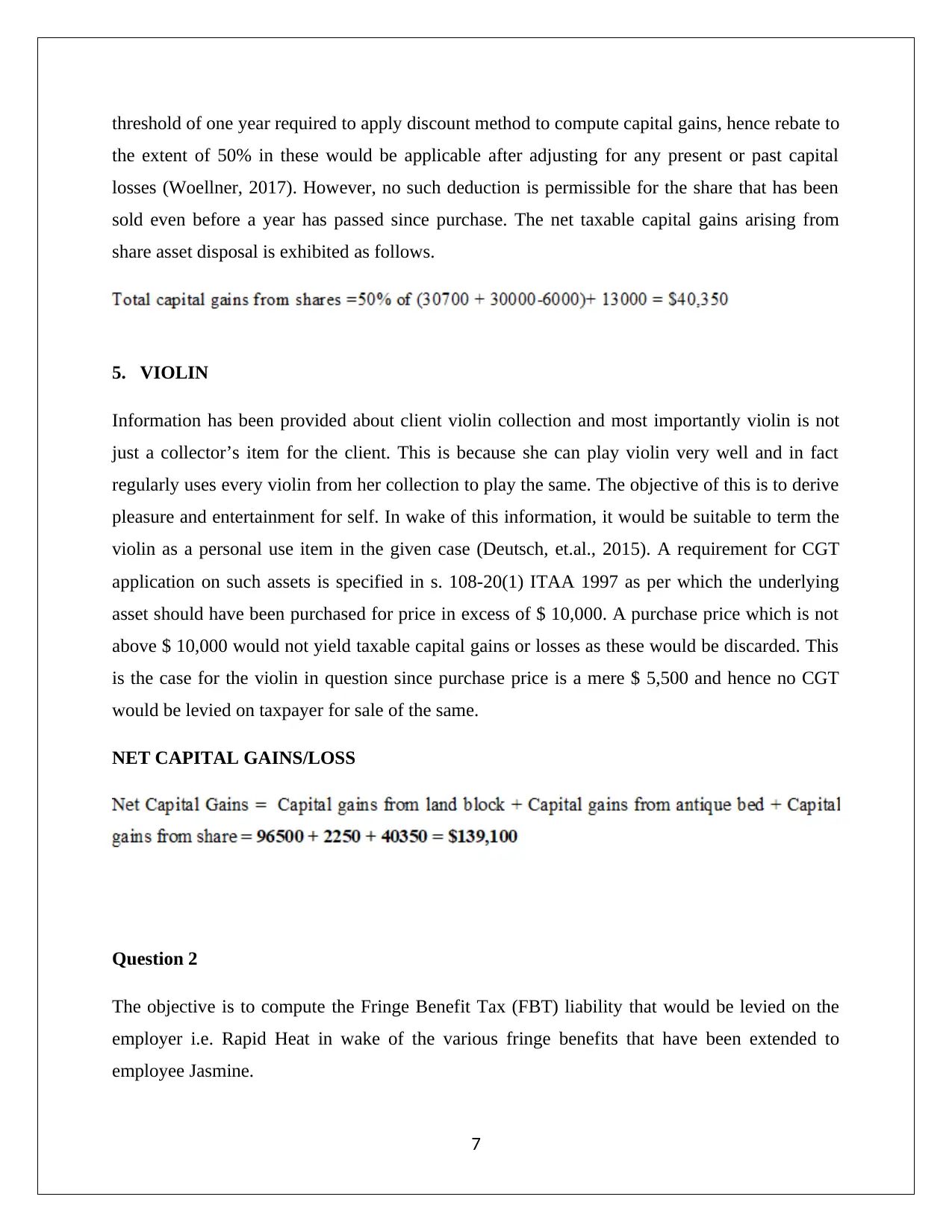
threshold of one year required to apply discount method to compute capital gains, hence rebate to
the extent of 50% in these would be applicable after adjusting for any present or past capital
losses (Woellner, 2017). However, no such deduction is permissible for the share that has been
sold even before a year has passed since purchase. The net taxable capital gains arising from
share asset disposal is exhibited as follows.
5. VIOLIN
Information has been provided about client violin collection and most importantly violin is not
just a collector’s item for the client. This is because she can play violin very well and in fact
regularly uses every violin from her collection to play the same. The objective of this is to derive
pleasure and entertainment for self. In wake of this information, it would be suitable to term the
violin as a personal use item in the given case (Deutsch, et.al., 2015). A requirement for CGT
application on such assets is specified in s. 108-20(1) ITAA 1997 as per which the underlying
asset should have been purchased for price in excess of $ 10,000. A purchase price which is not
above $ 10,000 would not yield taxable capital gains or losses as these would be discarded. This
is the case for the violin in question since purchase price is a mere $ 5,500 and hence no CGT
would be levied on taxpayer for sale of the same.
NET CAPITAL GAINS/LOSS
Question 2
The objective is to compute the Fringe Benefit Tax (FBT) liability that would be levied on the
employer i.e. Rapid Heat in wake of the various fringe benefits that have been extended to
employee Jasmine.
7
the extent of 50% in these would be applicable after adjusting for any present or past capital
losses (Woellner, 2017). However, no such deduction is permissible for the share that has been
sold even before a year has passed since purchase. The net taxable capital gains arising from
share asset disposal is exhibited as follows.
5. VIOLIN
Information has been provided about client violin collection and most importantly violin is not
just a collector’s item for the client. This is because she can play violin very well and in fact
regularly uses every violin from her collection to play the same. The objective of this is to derive
pleasure and entertainment for self. In wake of this information, it would be suitable to term the
violin as a personal use item in the given case (Deutsch, et.al., 2015). A requirement for CGT
application on such assets is specified in s. 108-20(1) ITAA 1997 as per which the underlying
asset should have been purchased for price in excess of $ 10,000. A purchase price which is not
above $ 10,000 would not yield taxable capital gains or losses as these would be discarded. This
is the case for the violin in question since purchase price is a mere $ 5,500 and hence no CGT
would be levied on taxpayer for sale of the same.
NET CAPITAL GAINS/LOSS
Question 2
The objective is to compute the Fringe Benefit Tax (FBT) liability that would be levied on the
employer i.e. Rapid Heat in wake of the various fringe benefits that have been extended to
employee Jasmine.
7
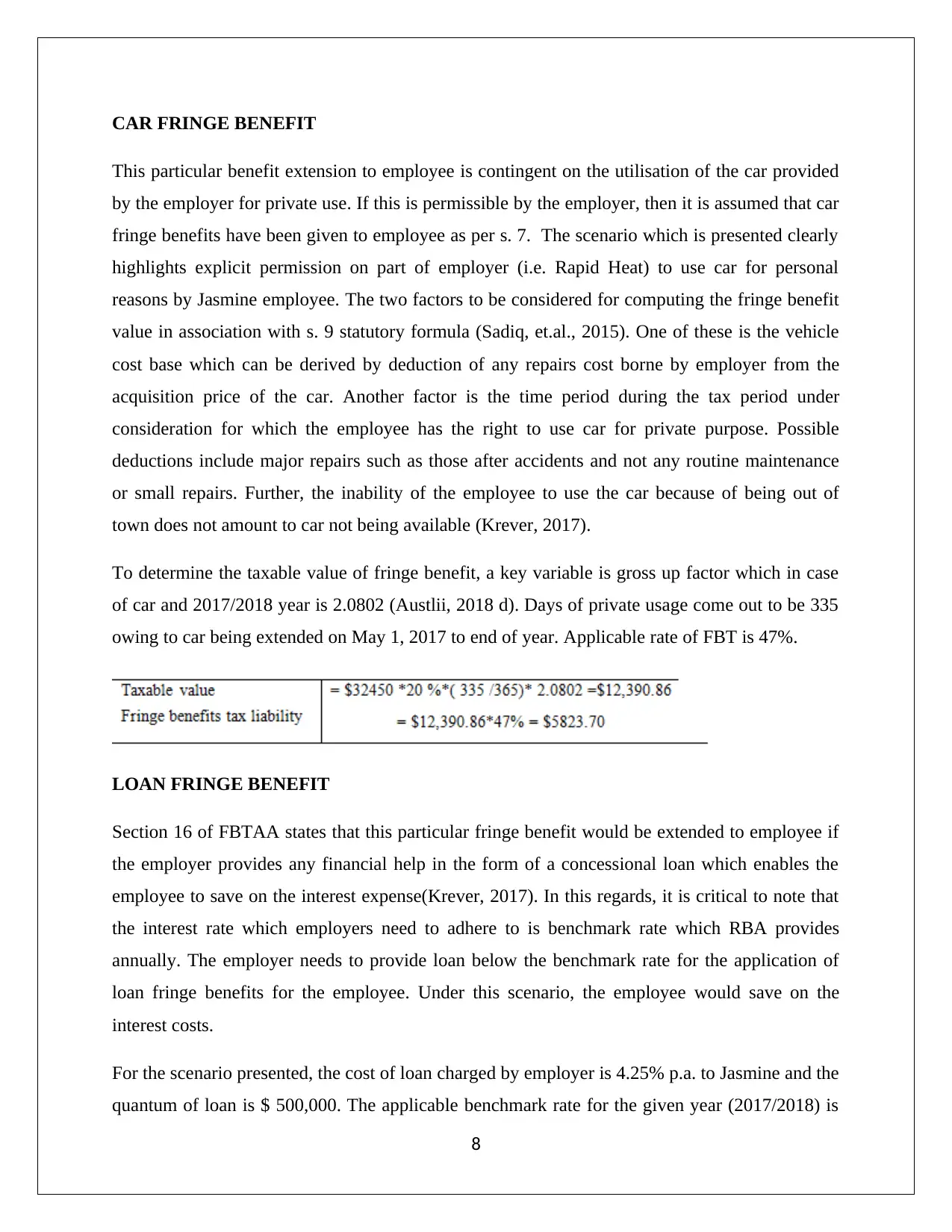
CAR FRINGE BENEFIT
This particular benefit extension to employee is contingent on the utilisation of the car provided
by the employer for private use. If this is permissible by the employer, then it is assumed that car
fringe benefits have been given to employee as per s. 7. The scenario which is presented clearly
highlights explicit permission on part of employer (i.e. Rapid Heat) to use car for personal
reasons by Jasmine employee. The two factors to be considered for computing the fringe benefit
value in association with s. 9 statutory formula (Sadiq, et.al., 2015). One of these is the vehicle
cost base which can be derived by deduction of any repairs cost borne by employer from the
acquisition price of the car. Another factor is the time period during the tax period under
consideration for which the employee has the right to use car for private purpose. Possible
deductions include major repairs such as those after accidents and not any routine maintenance
or small repairs. Further, the inability of the employee to use the car because of being out of
town does not amount to car not being available (Krever, 2017).
To determine the taxable value of fringe benefit, a key variable is gross up factor which in case
of car and 2017/2018 year is 2.0802 (Austlii, 2018 d). Days of private usage come out to be 335
owing to car being extended on May 1, 2017 to end of year. Applicable rate of FBT is 47%.
LOAN FRINGE BENEFIT
Section 16 of FBTAA states that this particular fringe benefit would be extended to employee if
the employer provides any financial help in the form of a concessional loan which enables the
employee to save on the interest expense(Krever, 2017). In this regards, it is critical to note that
the interest rate which employers need to adhere to is benchmark rate which RBA provides
annually. The employer needs to provide loan below the benchmark rate for the application of
loan fringe benefits for the employee. Under this scenario, the employee would save on the
interest costs.
For the scenario presented, the cost of loan charged by employer is 4.25% p.a. to Jasmine and the
quantum of loan is $ 500,000. The applicable benchmark rate for the given year (2017/2018) is
8
This particular benefit extension to employee is contingent on the utilisation of the car provided
by the employer for private use. If this is permissible by the employer, then it is assumed that car
fringe benefits have been given to employee as per s. 7. The scenario which is presented clearly
highlights explicit permission on part of employer (i.e. Rapid Heat) to use car for personal
reasons by Jasmine employee. The two factors to be considered for computing the fringe benefit
value in association with s. 9 statutory formula (Sadiq, et.al., 2015). One of these is the vehicle
cost base which can be derived by deduction of any repairs cost borne by employer from the
acquisition price of the car. Another factor is the time period during the tax period under
consideration for which the employee has the right to use car for private purpose. Possible
deductions include major repairs such as those after accidents and not any routine maintenance
or small repairs. Further, the inability of the employee to use the car because of being out of
town does not amount to car not being available (Krever, 2017).
To determine the taxable value of fringe benefit, a key variable is gross up factor which in case
of car and 2017/2018 year is 2.0802 (Austlii, 2018 d). Days of private usage come out to be 335
owing to car being extended on May 1, 2017 to end of year. Applicable rate of FBT is 47%.
LOAN FRINGE BENEFIT
Section 16 of FBTAA states that this particular fringe benefit would be extended to employee if
the employer provides any financial help in the form of a concessional loan which enables the
employee to save on the interest expense(Krever, 2017). In this regards, it is critical to note that
the interest rate which employers need to adhere to is benchmark rate which RBA provides
annually. The employer needs to provide loan below the benchmark rate for the application of
loan fringe benefits for the employee. Under this scenario, the employee would save on the
interest costs.
For the scenario presented, the cost of loan charged by employer is 4.25% p.a. to Jasmine and the
quantum of loan is $ 500,000. The applicable benchmark rate for the given year (2017/2018) is
8
⊘ This is a preview!⊘
Do you want full access?
Subscribe today to unlock all pages.

Trusted by 1+ million students worldwide
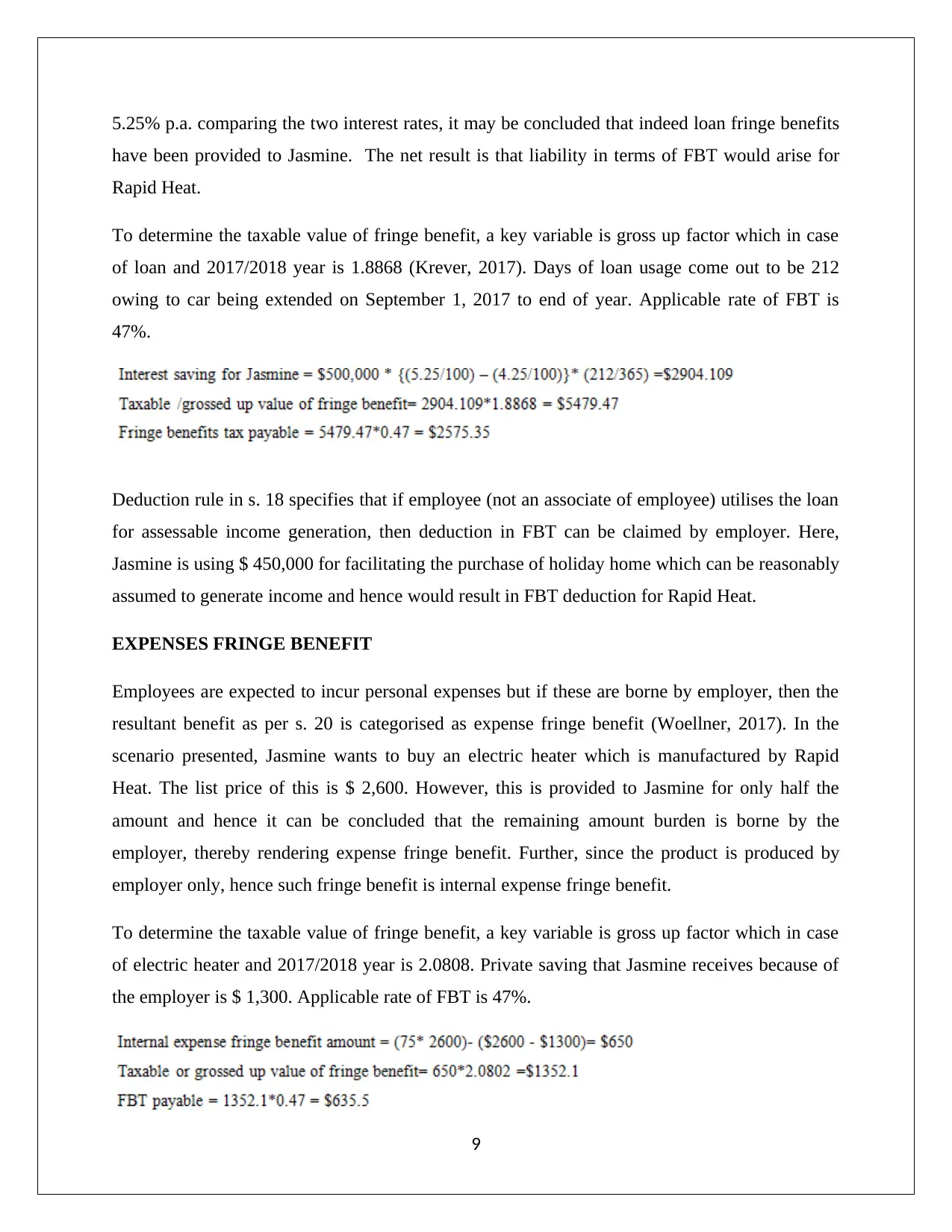
5.25% p.a. comparing the two interest rates, it may be concluded that indeed loan fringe benefits
have been provided to Jasmine. The net result is that liability in terms of FBT would arise for
Rapid Heat.
To determine the taxable value of fringe benefit, a key variable is gross up factor which in case
of loan and 2017/2018 year is 1.8868 (Krever, 2017). Days of loan usage come out to be 212
owing to car being extended on September 1, 2017 to end of year. Applicable rate of FBT is
47%.
Deduction rule in s. 18 specifies that if employee (not an associate of employee) utilises the loan
for assessable income generation, then deduction in FBT can be claimed by employer. Here,
Jasmine is using $ 450,000 for facilitating the purchase of holiday home which can be reasonably
assumed to generate income and hence would result in FBT deduction for Rapid Heat.
EXPENSES FRINGE BENEFIT
Employees are expected to incur personal expenses but if these are borne by employer, then the
resultant benefit as per s. 20 is categorised as expense fringe benefit (Woellner, 2017). In the
scenario presented, Jasmine wants to buy an electric heater which is manufactured by Rapid
Heat. The list price of this is $ 2,600. However, this is provided to Jasmine for only half the
amount and hence it can be concluded that the remaining amount burden is borne by the
employer, thereby rendering expense fringe benefit. Further, since the product is produced by
employer only, hence such fringe benefit is internal expense fringe benefit.
To determine the taxable value of fringe benefit, a key variable is gross up factor which in case
of electric heater and 2017/2018 year is 2.0808. Private saving that Jasmine receives because of
the employer is $ 1,300. Applicable rate of FBT is 47%.
9
have been provided to Jasmine. The net result is that liability in terms of FBT would arise for
Rapid Heat.
To determine the taxable value of fringe benefit, a key variable is gross up factor which in case
of loan and 2017/2018 year is 1.8868 (Krever, 2017). Days of loan usage come out to be 212
owing to car being extended on September 1, 2017 to end of year. Applicable rate of FBT is
47%.
Deduction rule in s. 18 specifies that if employee (not an associate of employee) utilises the loan
for assessable income generation, then deduction in FBT can be claimed by employer. Here,
Jasmine is using $ 450,000 for facilitating the purchase of holiday home which can be reasonably
assumed to generate income and hence would result in FBT deduction for Rapid Heat.
EXPENSES FRINGE BENEFIT
Employees are expected to incur personal expenses but if these are borne by employer, then the
resultant benefit as per s. 20 is categorised as expense fringe benefit (Woellner, 2017). In the
scenario presented, Jasmine wants to buy an electric heater which is manufactured by Rapid
Heat. The list price of this is $ 2,600. However, this is provided to Jasmine for only half the
amount and hence it can be concluded that the remaining amount burden is borne by the
employer, thereby rendering expense fringe benefit. Further, since the product is produced by
employer only, hence such fringe benefit is internal expense fringe benefit.
To determine the taxable value of fringe benefit, a key variable is gross up factor which in case
of electric heater and 2017/2018 year is 2.0808. Private saving that Jasmine receives because of
the employer is $ 1,300. Applicable rate of FBT is 47%.
9
Paraphrase This Document
Need a fresh take? Get an instant paraphrase of this document with our AI Paraphraser
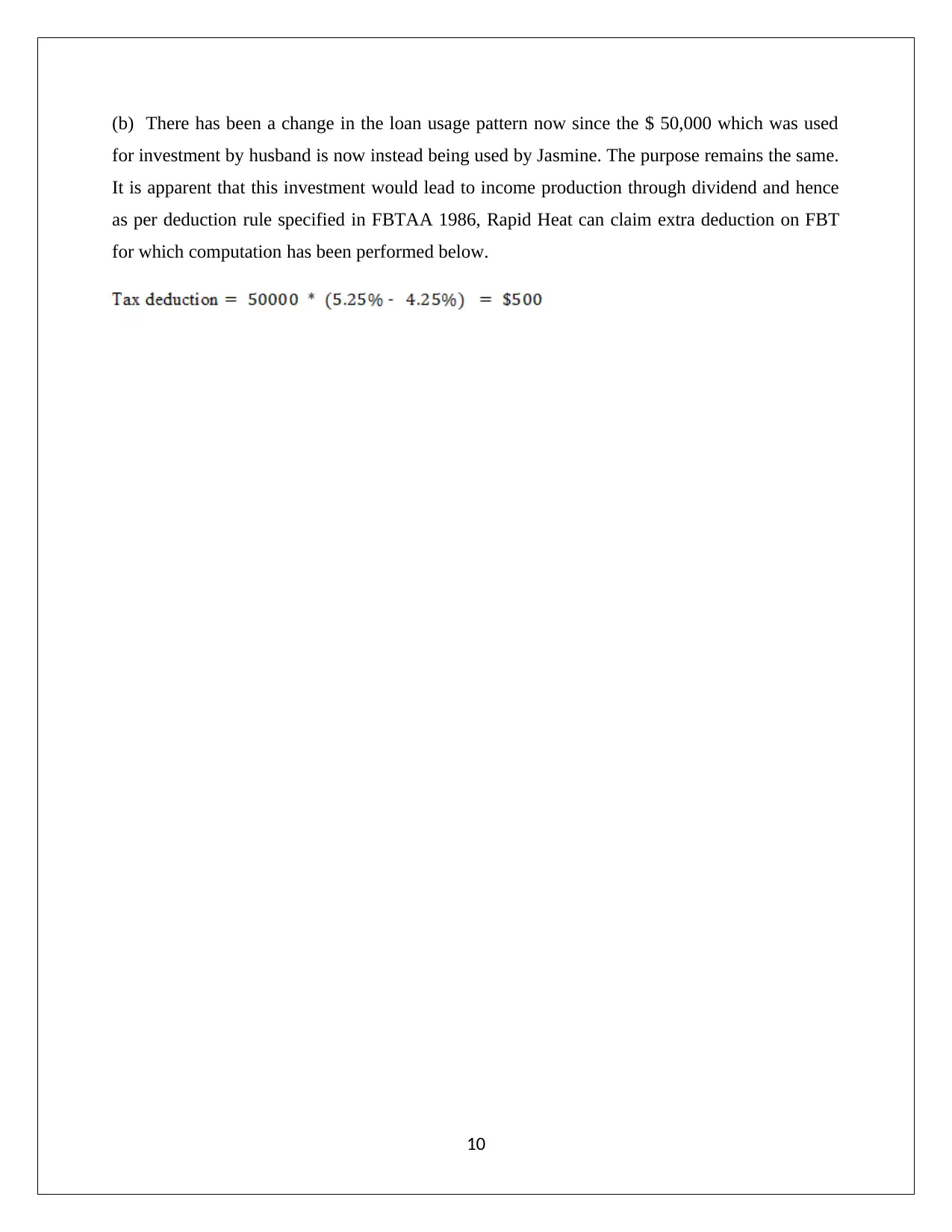
(b) There has been a change in the loan usage pattern now since the $ 50,000 which was used
for investment by husband is now instead being used by Jasmine. The purpose remains the same.
It is apparent that this investment would lead to income production through dividend and hence
as per deduction rule specified in FBTAA 1986, Rapid Heat can claim extra deduction on FBT
for which computation has been performed below.
10
for investment by husband is now instead being used by Jasmine. The purpose remains the same.
It is apparent that this investment would lead to income production through dividend and hence
as per deduction rule specified in FBTAA 1986, Rapid Heat can claim extra deduction on FBT
for which computation has been performed below.
10
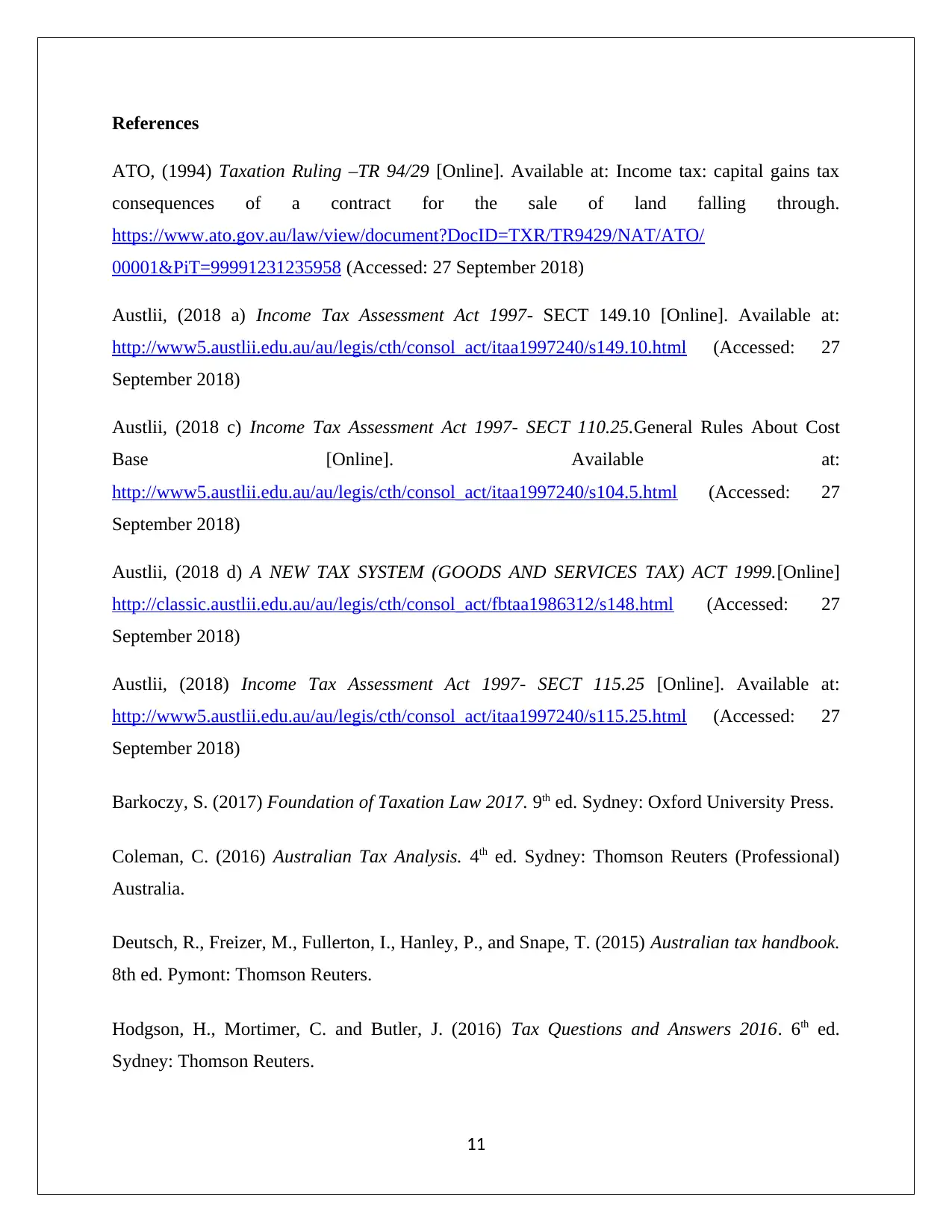
References
ATO, (1994) Taxation Ruling –TR 94/29 [Online]. Available at: Income tax: capital gains tax
consequences of a contract for the sale of land falling through.
https://www.ato.gov.au/law/view/document?DocID=TXR/TR9429/NAT/ATO/
00001&PiT=99991231235958 (Accessed: 27 September 2018)
Austlii, (2018 a) Income Tax Assessment Act 1997- SECT 149.10 [Online]. Available at:
http://www5.austlii.edu.au/au/legis/cth/consol_act/itaa1997240/s149.10.html (Accessed: 27
September 2018)
Austlii, (2018 c) Income Tax Assessment Act 1997- SECT 110.25.General Rules About Cost
Base [Online]. Available at:
http://www5.austlii.edu.au/au/legis/cth/consol_act/itaa1997240/s104.5.html (Accessed: 27
September 2018)
Austlii, (2018 d) A NEW TAX SYSTEM (GOODS AND SERVICES TAX) ACT 1999.[Online]
http://classic.austlii.edu.au/au/legis/cth/consol_act/fbtaa1986312/s148.html (Accessed: 27
September 2018)
Austlii, (2018) Income Tax Assessment Act 1997- SECT 115.25 [Online]. Available at:
http://www5.austlii.edu.au/au/legis/cth/consol_act/itaa1997240/s115.25.html (Accessed: 27
September 2018)
Barkoczy, S. (2017) Foundation of Taxation Law 2017. 9th ed. Sydney: Oxford University Press.
Coleman, C. (2016) Australian Tax Analysis. 4th ed. Sydney: Thomson Reuters (Professional)
Australia.
Deutsch, R., Freizer, M., Fullerton, I., Hanley, P., and Snape, T. (2015) Australian tax handbook.
8th ed. Pymont: Thomson Reuters.
Hodgson, H., Mortimer, C. and Butler, J. (2016) Tax Questions and Answers 2016. 6th ed.
Sydney: Thomson Reuters.
11
ATO, (1994) Taxation Ruling –TR 94/29 [Online]. Available at: Income tax: capital gains tax
consequences of a contract for the sale of land falling through.
https://www.ato.gov.au/law/view/document?DocID=TXR/TR9429/NAT/ATO/
00001&PiT=99991231235958 (Accessed: 27 September 2018)
Austlii, (2018 a) Income Tax Assessment Act 1997- SECT 149.10 [Online]. Available at:
http://www5.austlii.edu.au/au/legis/cth/consol_act/itaa1997240/s149.10.html (Accessed: 27
September 2018)
Austlii, (2018 c) Income Tax Assessment Act 1997- SECT 110.25.General Rules About Cost
Base [Online]. Available at:
http://www5.austlii.edu.au/au/legis/cth/consol_act/itaa1997240/s104.5.html (Accessed: 27
September 2018)
Austlii, (2018 d) A NEW TAX SYSTEM (GOODS AND SERVICES TAX) ACT 1999.[Online]
http://classic.austlii.edu.au/au/legis/cth/consol_act/fbtaa1986312/s148.html (Accessed: 27
September 2018)
Austlii, (2018) Income Tax Assessment Act 1997- SECT 115.25 [Online]. Available at:
http://www5.austlii.edu.au/au/legis/cth/consol_act/itaa1997240/s115.25.html (Accessed: 27
September 2018)
Barkoczy, S. (2017) Foundation of Taxation Law 2017. 9th ed. Sydney: Oxford University Press.
Coleman, C. (2016) Australian Tax Analysis. 4th ed. Sydney: Thomson Reuters (Professional)
Australia.
Deutsch, R., Freizer, M., Fullerton, I., Hanley, P., and Snape, T. (2015) Australian tax handbook.
8th ed. Pymont: Thomson Reuters.
Hodgson, H., Mortimer, C. and Butler, J. (2016) Tax Questions and Answers 2016. 6th ed.
Sydney: Thomson Reuters.
11
⊘ This is a preview!⊘
Do you want full access?
Subscribe today to unlock all pages.

Trusted by 1+ million students worldwide
1 out of 13
Related Documents
Your All-in-One AI-Powered Toolkit for Academic Success.
+13062052269
info@desklib.com
Available 24*7 on WhatsApp / Email
![[object Object]](/_next/static/media/star-bottom.7253800d.svg)
Unlock your academic potential
Copyright © 2020–2026 A2Z Services. All Rights Reserved. Developed and managed by ZUCOL.




